Friday, September 26, 2008
Defect / Dead Pixels on the sensor
Well, the dead pixels are back. On the Nikon website, they call these pixels 'defect pixels'. They have a description of the pixel. These pixels may not be seen in every photo you take if the shutter speed is lower than 1/2 seconds because of the Noise Reduction (NR) feature. However, in daylight and at faster, normal speed, these pixels will show up as white dots. These are a pixel-big dot, not a blurry blotch like a dust spot -- just one pixel. The exact reason is not clear but Nikon says environment factors could cause dead pixels to appear. I guess that means that exposure to perhaps humidity and heat can damage parts of the sensor. The one solution they have is to re-calibrate the camera. I can only guess what that means -- fixing the problem by intrapolating the value of the dead pixel by using the neighbouring pixels. Well, I have four dead pixels. Four pixels out of 10+ millions. You can barely notice them but since I know where they are, my eyes are drawn to them now. I need to check my warranty card and take the D80 in for repair. I wish there was a way to re-calibrate the camera myself
Thursday, September 25, 2008
Polarizing Filter, part 5
In my last post about the circular polarizer, I showed how the polarizer cut into the corner of the frame at 18mm. I should have qualified that observation with the fact that the polarizer was placed in front of a Neutral Density filter. At 18mm, not much can be added in front of the lens. A wall of maybe half a centimetre is about the maximum. Below is an 18mm shot with just the polarizer on -- the ND filter and the petal are on the table. The darkened corners are gone.
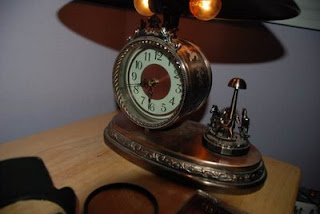

Sunday, September 21, 2008
D80 and SB-800 high speed flash sync
This modern piece of electronics is sure packed with a ton of features. Add a hot shoe flash and the feature set just got expanded by another 50 different options, or maybe more.
When the SB-800 was shoed on the D80 in the Aperture Priority shooting mode, I noticed that the shutter speed was always at a constant 1/60 seconds regardless of what aperture setting I dialed. Could there not be a way to increase the shutter speed? There is.
Last night, my mind got really curious. I could not understand why I could not shoot faster than 1/60 seconds with flash. 1/60 seconds is fast and the flash would freeze your subject but 1/60 seconds is still slow if your subject is a fluttering hummingbird. Well, I did some testing and so far this is what I found out.
First, the maximum flash sync speed, which is the fastest shutter speed possible where the whole sensor is exposed to light, of the D80 is 1/200 seconds. That speed is how fast a Focal Plane shutter curtain can move across the sensor surface. Faster than this shutter speed, the two shutter curtains will move in tandem with a small gap equal to the shutter speed between them. Without the SB-800 speedlight, the fastest shutter speed when flash is used is 1/200 seconds.
With the built-in flash, in Aperture Priority mode, for some reason I cannot understand yet, the fastest shutter speed is 1/60 seconds. In Manual and Shutter Speed Priority modes, the fastest speed can be set to 1/200 seconds. So, if you want to shoot at speeds faster than 1/60 seconds with the built-in flash, you need to switch over to Manual or Shutter Speed Priority.
With the SB-800, it is possible to go beyond the 1/200 seconds limit. On the Nikon D80, Custom Menu item #25 is called 'Auto FP'. FP stands for Focal Plane, referring to the Focal Plane shutter curtains. Auto FP should be turned on to enable automatic High Speed Sync between the D80 shutter and the SB-800. This will allow the camera to shoot at speeds up to 1/4000. For an explanation of how the Focal Plane shutter works, I highly recommend this article by Derek K. Miller (the best explanation, albeit a little long, of how the shutter curtains work I have read so far) and this video of the Nikon D3 shutter.
Once you have turned on 'Auto FP', it is still not possible to use speeds faster than 1/60 seconds in Aperture Priority mode. You need to switch over to Manual or Shutter Speed Priority to crank the shutter speed all the way to 1/4000 seconds. This is very cool but I wonder if it is any useful. The fact is, at speeds past the maximum sync speed, say 1/500 seconds, the second Focal Plane shutter curtain trails the first curtain by 1/500 seconds, i.e. exposing the sensor to light by a slit that lasts only that much time. When the flash pops (not a single flash but multiple flashes, i.e. strobes) the sensor is exposed to the reflected light through a moving slit. The slit moves down the sensor surface in 1/200 seconds. I wonder if shooting a fluttering hummingbird at a shutter speed of 1/500 this way is better (strobing light) than simply keeping the shutter speed within the maximum flash sync range (one flash pop).
When the SB-800 was shoed on the D80 in the Aperture Priority shooting mode, I noticed that the shutter speed was always at a constant 1/60 seconds regardless of what aperture setting I dialed. Could there not be a way to increase the shutter speed? There is.
Last night, my mind got really curious. I could not understand why I could not shoot faster than 1/60 seconds with flash. 1/60 seconds is fast and the flash would freeze your subject but 1/60 seconds is still slow if your subject is a fluttering hummingbird. Well, I did some testing and so far this is what I found out.
First, the maximum flash sync speed, which is the fastest shutter speed possible where the whole sensor is exposed to light, of the D80 is 1/200 seconds. That speed is how fast a Focal Plane shutter curtain can move across the sensor surface. Faster than this shutter speed, the two shutter curtains will move in tandem with a small gap equal to the shutter speed between them. Without the SB-800 speedlight, the fastest shutter speed when flash is used is 1/200 seconds.
With the built-in flash, in Aperture Priority mode, for some reason I cannot understand yet, the fastest shutter speed is 1/60 seconds. In Manual and Shutter Speed Priority modes, the fastest speed can be set to 1/200 seconds. So, if you want to shoot at speeds faster than 1/60 seconds with the built-in flash, you need to switch over to Manual or Shutter Speed Priority.
With the SB-800, it is possible to go beyond the 1/200 seconds limit. On the Nikon D80, Custom Menu item #25 is called 'Auto FP'. FP stands for Focal Plane, referring to the Focal Plane shutter curtains. Auto FP should be turned on to enable automatic High Speed Sync between the D80 shutter and the SB-800. This will allow the camera to shoot at speeds up to 1/4000. For an explanation of how the Focal Plane shutter works, I highly recommend this article by Derek K. Miller (the best explanation, albeit a little long, of how the shutter curtains work I have read so far) and this video of the Nikon D3 shutter.
Once you have turned on 'Auto FP', it is still not possible to use speeds faster than 1/60 seconds in Aperture Priority mode. You need to switch over to Manual or Shutter Speed Priority to crank the shutter speed all the way to 1/4000 seconds. This is very cool but I wonder if it is any useful. The fact is, at speeds past the maximum sync speed, say 1/500 seconds, the second Focal Plane shutter curtain trails the first curtain by 1/500 seconds, i.e. exposing the sensor to light by a slit that lasts only that much time. When the flash pops (not a single flash but multiple flashes, i.e. strobes) the sensor is exposed to the reflected light through a moving slit. The slit moves down the sensor surface in 1/200 seconds. I wonder if shooting a fluttering hummingbird at a shutter speed of 1/500 this way is better (strobing light) than simply keeping the shutter speed within the maximum flash sync range (one flash pop).
Saturday, September 20, 2008
Vivitar 70-210mm f3.5
My Series 1 Vivitar 70-210mm f3.5 FX lens has been sitting on the sideline ever since I acquired the 80-400mm Tokina. The truth is, it is heavy (weighting a whopping 0.879 kg) and it is manual focus. I ended up using a lighter and easier lens for telezoom shots.
Today, I got curious about flash and the manual lenses. I wondered how I could use flash with a manual focus lens. Whenever I trie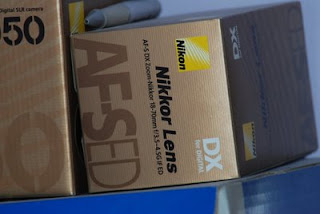 d an MF lens, the flash icon on my LCD would blink, telling me it cannot activate the built-in flash. Well, today, I decided to shoe in my SB-800 speedlight, as I know it can be operated in manual mode. In manual mode, you set the output strength and the flash fires when the shutter opens. Simple operation. I then got curious. Can my D80 set the built-in flash to manual mode as well? I kicked myself in the butt after looking up the menu. Truth be told, my memory is getting rusty because I have looked at this menu before. The option to turn on manual mode is there, I just forgot about it. So now I could simply use the built-in flash in many situations with MF lenses. I am getting off tangent ...
d an MF lens, the flash icon on my LCD would blink, telling me it cannot activate the built-in flash. Well, today, I decided to shoe in my SB-800 speedlight, as I know it can be operated in manual mode. In manual mode, you set the output strength and the flash fires when the shutter opens. Simple operation. I then got curious. Can my D80 set the built-in flash to manual mode as well? I kicked myself in the butt after looking up the menu. Truth be told, my memory is getting rusty because I have looked at this menu before. The option to turn on manual mode is there, I just forgot about it. So now I could simply use the built-in flash in many situations with MF lenses. I am getting off tangent ...
So, I wanted to test my Vivitar lens again because I forgot how good or bad it was. The lens is still in perfect condition. The lens bod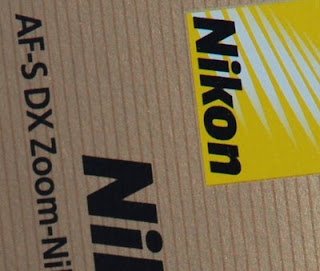 y is made out of real metal, hence its weight, unlike most of the new plastic lenses made today. The body feels cold because of the metal and the glass looks pristine clean. In my room, I took a few shots with it with manual flash at ISO200, 210mm, f/9. I must say I am impressed with what a piece of 1975 techno craft can do. The image came out nearly task sharp. You sharpen it up a little in Photoshop (or Irfanview what I use) and the image is crystal clear.
y is made out of real metal, hence its weight, unlike most of the new plastic lenses made today. The body feels cold because of the metal and the glass looks pristine clean. In my room, I took a few shots with it with manual flash at ISO200, 210mm, f/9. I must say I am impressed with what a piece of 1975 techno craft can do. The image came out nearly task sharp. You sharpen it up a little in Photoshop (or Irfanview what I use) and the image is crystal clear.
The first image is from the Vivitar, image resized to 1024x685. It is shot of a set of boxes of a D50 and Nikkor AF-S 18-70mm lens that my older brother bought a few years ago. The second image is a crop at maximum resolution from the original 3872x2592 JPEG image. The images look very clean and sharp.
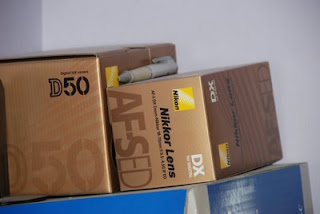
The third image is from my Nikkor 18-200mm DX lens. It was shot at ISO200, 200mm, f/5.6 with the built-in flash set to TTL. As far as image quality is concerend, there is no difference that I can see between this shot and the Vivitar shot. There is one thing to notice here though. At 210mm, the FX Vivitar looks more like a 300mm DX lens.
The fourth image is a crop at maximum resolution of the Nikon shot. The crop is slightly different. The Vivitar crop is sharp but has more noise than the Nikkor crop. However, it is probably due to lower flash output than the Nikkor TTL shot.
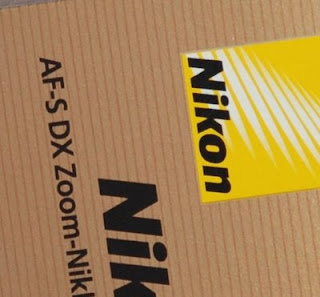
The Vivitar lens is a really nice and sharp lens. It is a legacy lens manufactured by Kiron for Vivitar back in 1975. I like this classic of classics. I want to sell the Vivitar lens though so I can put the money toward a better lens. Perhaps I will take it out a few times first. It will be sad to see it go, if anyone will still want to buy this piece of art.
Today, I got curious about flash and the manual lenses. I wondered how I could use flash with a manual focus lens. Whenever I trie
 d an MF lens, the flash icon on my LCD would blink, telling me it cannot activate the built-in flash. Well, today, I decided to shoe in my SB-800 speedlight, as I know it can be operated in manual mode. In manual mode, you set the output strength and the flash fires when the shutter opens. Simple operation. I then got curious. Can my D80 set the built-in flash to manual mode as well? I kicked myself in the butt after looking up the menu. Truth be told, my memory is getting rusty because I have looked at this menu before. The option to turn on manual mode is there, I just forgot about it. So now I could simply use the built-in flash in many situations with MF lenses. I am getting off tangent ...
d an MF lens, the flash icon on my LCD would blink, telling me it cannot activate the built-in flash. Well, today, I decided to shoe in my SB-800 speedlight, as I know it can be operated in manual mode. In manual mode, you set the output strength and the flash fires when the shutter opens. Simple operation. I then got curious. Can my D80 set the built-in flash to manual mode as well? I kicked myself in the butt after looking up the menu. Truth be told, my memory is getting rusty because I have looked at this menu before. The option to turn on manual mode is there, I just forgot about it. So now I could simply use the built-in flash in many situations with MF lenses. I am getting off tangent ...So, I wanted to test my Vivitar lens again because I forgot how good or bad it was. The lens is still in perfect condition. The lens bod
 y is made out of real metal, hence its weight, unlike most of the new plastic lenses made today. The body feels cold because of the metal and the glass looks pristine clean. In my room, I took a few shots with it with manual flash at ISO200, 210mm, f/9. I must say I am impressed with what a piece of 1975 techno craft can do. The image came out nearly task sharp. You sharpen it up a little in Photoshop (or Irfanview what I use) and the image is crystal clear.
y is made out of real metal, hence its weight, unlike most of the new plastic lenses made today. The body feels cold because of the metal and the glass looks pristine clean. In my room, I took a few shots with it with manual flash at ISO200, 210mm, f/9. I must say I am impressed with what a piece of 1975 techno craft can do. The image came out nearly task sharp. You sharpen it up a little in Photoshop (or Irfanview what I use) and the image is crystal clear.The first image is from the Vivitar, image resized to 1024x685. It is shot of a set of boxes of a D50 and Nikkor AF-S 18-70mm lens that my older brother bought a few years ago. The second image is a crop at maximum resolution from the original 3872x2592 JPEG image. The images look very clean and sharp.

The third image is from my Nikkor 18-200mm DX lens. It was shot at ISO200, 200mm, f/5.6 with the built-in flash set to TTL. As far as image quality is concerend, there is no difference that I can see between this shot and the Vivitar shot. There is one thing to notice here though. At 210mm, the FX Vivitar looks more like a 300mm DX lens.
The fourth image is a crop at maximum resolution of the Nikon shot. The crop is slightly different. The Vivitar crop is sharp but has more noise than the Nikkor crop. However, it is probably due to lower flash output than the Nikkor TTL shot.

The Vivitar lens is a really nice and sharp lens. It is a legacy lens manufactured by Kiron for Vivitar back in 1975. I like this classic of classics. I want to sell the Vivitar lens though so I can put the money toward a better lens. Perhaps I will take it out a few times first. It will be sad to see it go, if anyone will still want to buy this piece of art.
Wednesday, September 17, 2008
Bridging two worlds
If the Nikon D90 is any indication that the two worlds of DSLRs and point-and-shoot systems are gravitating toward one another, we are soon enough going to see more such devices that might redefine social status in the camera world.
Just a week ago, Panasonic revealed its newest camera, the Lumix DMC-G1. I saw two articles describing it as the smallest and lightest DSLR camera in the world. Ok, I was intrigued so I had to read more about it. Yes, it was definitely smaller and lighter than any DSLR. However, by definition, a DSLR is a Digital Single-Lens Reflex camera. There is a single lens that light shines through and what we see through the optical viewfinder is what the film or digital sensor captures. (That is, what you see is what you get, sort of.) This is possible because of a reflex mirror that reflects light to the optical viewfinder. The reflex mirror flips up when the shutter button is depressed and an image is taken on the film or digital sensor.
The Limux DMC-G1 does not have a reflex mirror nor does it have an optical viewfinder. The lack of the mirror, the pentaprism, and the optical viewfinder allows for a lighter and smaller camera design. To describe the Limux DMC-G1 as a DSLR is thus not correct. What is it then? It works exactly like a point-and-shoot camera with the ability to change lenses -- but some point-and-shoot cameras already have this feature. The difference however is that the Limux DMC-G1 can use normal DSLR size lenses whereas the other point-and-shoot cameras use special smaller point-and-shoot lenses. Also, with a bigger DSLR size sensor, the Limux will capture higher quality images than the smaller point-and-shoots.
So, the Limux DMC-G1 is an expensive point-and-shoot camera that has a mount for normal DSLR size lenses. The gap between the two worlds is collapsing quickly but will the performance of these DSLR looking designs ever rival the more advanced true DSLRs?
Just a week ago, Panasonic revealed its newest camera, the Lumix DMC-G1. I saw two articles describing it as the smallest and lightest DSLR camera in the world. Ok, I was intrigued so I had to read more about it. Yes, it was definitely smaller and lighter than any DSLR. However, by definition, a DSLR is a Digital Single-Lens Reflex camera. There is a single lens that light shines through and what we see through the optical viewfinder is what the film or digital sensor captures. (That is, what you see is what you get, sort of.) This is possible because of a reflex mirror that reflects light to the optical viewfinder. The reflex mirror flips up when the shutter button is depressed and an image is taken on the film or digital sensor.
The Limux DMC-G1 does not have a reflex mirror nor does it have an optical viewfinder. The lack of the mirror, the pentaprism, and the optical viewfinder allows for a lighter and smaller camera design. To describe the Limux DMC-G1 as a DSLR is thus not correct. What is it then? It works exactly like a point-and-shoot camera with the ability to change lenses -- but some point-and-shoot cameras already have this feature. The difference however is that the Limux DMC-G1 can use normal DSLR size lenses whereas the other point-and-shoot cameras use special smaller point-and-shoot lenses. Also, with a bigger DSLR size sensor, the Limux will capture higher quality images than the smaller point-and-shoots.
So, the Limux DMC-G1 is an expensive point-and-shoot camera that has a mount for normal DSLR size lenses. The gap between the two worlds is collapsing quickly but will the performance of these DSLR looking designs ever rival the more advanced true DSLRs?
Sunday, September 14, 2008
How strong is the SB-800 ?

In the upper left corner is a picture of a couple of AA batteries from my speedlight. There are definite burn marks. In fact, all my AA batteries used in this speedlight have burn marks on the negative plate. I guess it is like welding. A electrical current jumps across two electrodes and if strong enough will weld metal together. If not strong enough, it will just burn the contact points.
Now, the burn marks are not just soot. After wiping the burn marks as clean as I can, I can see definite puncture mark into the negative metal plate of the batteries. I think I know what people are saying about leaking then. If used long enough, the puncture mark may eventually drill through the plate and burn into the cell compartment.
Well, I will not remove the batteries but will check them after every session.
Thursday, September 11, 2008
Nikon D90
A little while ago I posted a link to a joke about a non-existent D90 (http://photonfarmers.blogspot.com/search?q=d90). Well, the joke is no longer. It would appear that Nikon will unveil a new D90 at the end of this month. I started reading up on the new toy and it seems to be making a quantum shift in the DSLR paradigm.
The D90 is a still image camera first and foremost but is also the first DSLR with video shooting capability that I know. Say what? Well, it can shoot video too. If you think that Nikon is bridging the DSLR with the Point-and-Shoot worls, you may be right. It would also seem that they are already moving in that direction with the Live View screens in the D300, D3, and D700. I for one did not like that idea so much. I like to keep the workings of a DSLR in the ways of the 35mm film SLR. It separates a DSLR from a Point-and-Shoot. On the other hand, a DSLR is already so different from the 35mm SLR, so why not go even further? I guess there is no really good reason not to go further.
Now, there is one feature I am quite excited about. I am happy that Nikon is sporting their new DSLRs with a CMOS sensor. It is supposed to produce the same picture quality as the D300 up to ISO 6400. I am hoping it can produce the same picture quality as the D3 and D700 but unfortunately there is no way possible to compare with the FX sensors of the latter DSLRs.
So, the D90 will be born. Henry's Photographics and Imaging Show is coming up. I will surely be testing it out. Will I upgrade my D80? Yes, mainly for better image quality at high ISO, but to a D90 (about $1000) or a D700 (about $2700) ?
The D90 is a still image camera first and foremost but is also the first DSLR with video shooting capability that I know. Say what? Well, it can shoot video too. If you think that Nikon is bridging the DSLR with the Point-and-Shoot worls, you may be right. It would also seem that they are already moving in that direction with the Live View screens in the D300, D3, and D700. I for one did not like that idea so much. I like to keep the workings of a DSLR in the ways of the 35mm film SLR. It separates a DSLR from a Point-and-Shoot. On the other hand, a DSLR is already so different from the 35mm SLR, so why not go even further? I guess there is no really good reason not to go further.
Now, there is one feature I am quite excited about. I am happy that Nikon is sporting their new DSLRs with a CMOS sensor. It is supposed to produce the same picture quality as the D300 up to ISO 6400. I am hoping it can produce the same picture quality as the D3 and D700 but unfortunately there is no way possible to compare with the FX sensors of the latter DSLRs.
So, the D90 will be born. Henry's Photographics and Imaging Show is coming up. I will surely be testing it out. Will I upgrade my D80? Yes, mainly for better image quality at high ISO, but to a D90 (about $1000) or a D700 (about $2700) ?
Wednesday, September 3, 2008
Black and white, part 2
 This black and white is more interesting than the colour version I must say. This photo really captures the feeling I had of Cuba when I was on the ground of Plaza Mayor and Casa de Musica -- an old rustic city with character, a people that wear a smile on their face as they blare music at Casa de Musica into the night.
This black and white is more interesting than the colour version I must say. This photo really captures the feeling I had of Cuba when I was on the ground of Plaza Mayor and Casa de Musica -- an old rustic city with character, a people that wear a smile on their face as they blare music at Casa de Musica into the night.
Black and white
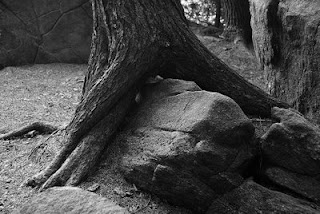 Exploring the art of photography, I have started to convert some of my pictures to grayscale, sharpened the features a little and accentuate the contrast to bring out the interesting ruggedness of the subject of the photo.
Exploring the art of photography, I have started to convert some of my pictures to grayscale, sharpened the features a little and accentuate the contrast to bring out the interesting ruggedness of the subject of the photo.Simple software such as Irfanview and The Gimp makes this process extremely simple and quick. Bring up their colour adjustment tool, and make a few adjustments here and there. The only other thing I am wishing for is what Nikon Capture NX and PhotoShop can do, and that is the ability to tweak small areas of your photo. For example, if I was editing a photo of a person, I might like to sharpen only the eyes and smoothen out the rest of the face. Perhaps I am not as adept at using my current tools as I could be. Anyways, I am rambling on here ...
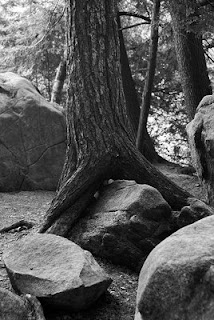 I like the effects of black and white. It focuses on the simple textures and simple composition. I will like to go back to some pictures I took from Cuba and turn some of the people shots into black and white.
I like the effects of black and white. It focuses on the simple textures and simple composition. I will like to go back to some pictures I took from Cuba and turn some of the people shots into black and white.
Subscribe to:
Comments (Atom)
Potensic Atom Follow-Me Mode
The Potensic Atom's Follow-Me mode is one of its "intelligent flight" modes. It's a really nifty feature that uses visual...

-
Here's a tip for flying the Potensic Atom's Return Home feature. First, take off from an open space with no obstruction such that ...
-
A local Zellers store is having liquidation sales of everything in the store. I was browsing through some electronics the other day--not pl...
-
The Potensic Atom's Follow-Me mode is one of its "intelligent flight" modes. It's a really nifty feature that uses visual...